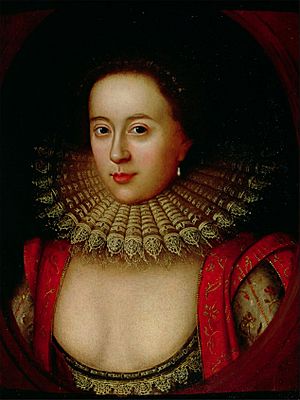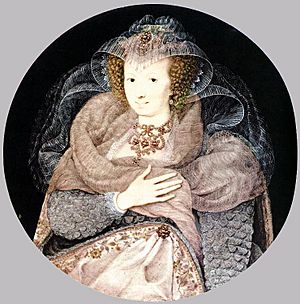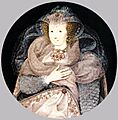Frances Carr, Countess of Somerset facts for kids
Quick facts for kids
Frances Carr
|
|
|---|---|
| Countess of Somerset | |

Frances Howard, Countess of Somerset
|
|
| Born | 31 May 1590 |
| Died | 23 August 1632 (aged 42) Chiswick, London, England |
| Buried | 27 August 1632 St Mary the Virgin, Saffron Walden, Essex, England |
| Noble family | Howard family |
| Spouse(s) | Robert Devereux, 3rd Earl of Essex Robert Carr, 1st Earl of Somerset |
| Issue | Anne Russell, Countess of Bedford |
| Father | Thomas Howard, 1st Earl of Suffolk |
| Mother | Catherine Knyvett |

Frances Carr, Countess of Somerset (born Frances Howard, 31 May 1590 – 23 August 1632), was an English noblewoman. She was involved in a major event during the time of King James I. She was found responsible for a serious crime but was not executed. The King later pardoned her, and she was set free from the Tower of London in 1622.
Contents
Her Family Background
Frances Howard was born into a powerful family. Her father was Lord Thomas Howard. He later became the 1st Earl of Suffolk. Her mother was Catherine Knyvet.
Frances's family was very important in England. Her grandfather was Thomas Howard, 4th Duke of Norfolk. He was a rich and influential nobleman.
Her First Marriage
When Frances was 14, she married Robert Devereux, 3rd Earl of Essex. He was 13 years old. This marriage was mainly for political reasons. Because they were so young, they did not live together.
Her husband traveled in Europe from 1607 to 1609. When he came back, Frances tried to avoid him. She had fallen in love with Robert Carr, 1st Earl of Somerset.
Frances wanted her marriage to be ended. Her father and uncle helped her with this. The King, James I, also got involved. This was because Robert Carr was a favorite of the King. The King agreed to end her first marriage on 25 September 1613. Frances then married Robert Carr on 26 December 1613.
A Troubling Event
Sir Thomas Overbury was a close friend of Robert Carr. He tried to tell Carr not to marry Frances Howard. But the Howard family was very powerful.
The King was persuaded to offer Overbury a job as Ambassador to Russia. They knew he would refuse to stay near Carr. When Overbury refused, the King saw it as an insult. Overbury was then sent to the Tower of London. He died there.
Later, in 1615, an assistant confessed something. He said he was paid to give Frances poisons. This was to harm Overbury. The King's Secretary of State, Sir Ralph Winwood, told the King. The King asked his advisors to investigate.
The investigation showed that Frances had been giving Overbury harmful substances. She put them in jellies and tarts. The Lieutenant of the Tower, Gervase Helwys, found out about this. He tried to stop the harmful food.
However, Frances eventually succeeded in harming Overbury. She used a smuggled enema with a harmful substance.
Arrest and Outcome
Frances and her husband were arrested in October 1615. Frances admitted her part in the event. Her husband said he was innocent.
In 1616, Frances was found responsible for the crime. Her husband was found responsible for helping cover it up. They were first sentenced to death. But King James I changed this. They were instead kept in the Tower of London for life.
The King pardoned them in January 1622. They were then released from prison. Frances died 10 years later when she was 42.
Frances and Robert Carr had one daughter, Anne. Anne was born while Frances was under house arrest. Anne was cared for by Frances's sister, Lady Knollys. Anne later married William Russell, 1st Duke of Bedford.
Frances was buried at her family's home, Audley End, in Essex.
Images for kids
-
Frances Howard, portrait miniature by Isaac Oliver



